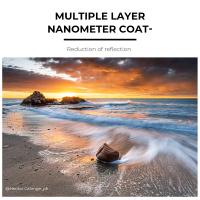What Does Magnification Mean On A Microscope ?
Magnification on a microscope refers to the ability of the microscope to enlarge the size of an object being observed. It is a measure of how much larger the image of the object appears compared to its actual size. Magnification is achieved by using a combination of lenses in the microscope, including the objective lens and the eyepiece lens. The objective lens is responsible for gathering light and forming a magnified image of the specimen, which is then further magnified by the eyepiece lens. The total magnification of a microscope is calculated by multiplying the magnification of the objective lens by the magnification of the eyepiece lens. For example, if the objective lens has a magnification of 10x and the eyepiece lens has a magnification of 20x, the total magnification would be 200x. Higher magnification allows for more detailed observation of the specimen, but it is important to note that increasing magnification does not necessarily mean better image quality, as factors like resolution and clarity also play a role.
1、 Optical Magnification: Enlargement of an image through lenses.
Magnification on a microscope refers to the process of enlarging an image through the use of lenses. It is a fundamental concept in microscopy that allows scientists and researchers to observe objects at a much larger scale than what is visible to the naked eye.
Optical magnification is achieved by using a combination of objective lenses and eyepieces. The objective lens is located close to the specimen and captures the light that passes through it. This light is then further magnified by the eyepiece, which is positioned near the observer's eye. The total magnification is determined by multiplying the magnification of the objective lens by the magnification of the eyepiece.
The primary purpose of magnification in microscopy is to enhance the level of detail and resolution of the specimen being observed. By enlarging the image, scientists can study the fine structures and characteristics of cells, tissues, and other microscopic entities. This is particularly important in fields such as biology, medicine, and materials science, where the ability to visualize and analyze minute details is crucial.
It is worth noting that magnification alone does not guarantee a clear and accurate image. Factors such as the quality of the lenses, the numerical aperture, and the resolution of the microscope also play a significant role in determining the level of detail that can be observed. Additionally, advancements in technology have led to the development of more sophisticated microscopy techniques, such as electron microscopy, which offer even higher levels of magnification and resolution.
In conclusion, magnification on a microscope refers to the enlargement of an image through lenses. It is a fundamental concept in microscopy that allows scientists to observe and study microscopic entities in greater detail. While magnification is essential, it is just one aspect of microscopy, and other factors also contribute to the overall quality of the image.

2、 Total Magnification: Product of objective and eyepiece magnification.
Magnification on a microscope refers to the ability of the microscope to enlarge an object or specimen being observed. It is a crucial aspect of microscopy as it allows scientists, researchers, and students to see details that are not visible to the naked eye.
Total magnification is the product of the objective and eyepiece magnification. The objective lens is located near the specimen and provides the primary magnification, while the eyepiece lens is located near the viewer's eye and further magnifies the image produced by the objective lens. By multiplying these two magnifications together, the total magnification is determined.
The total magnification is important because it determines the level of detail that can be observed. Higher magnification allows for a closer examination of the specimen, revealing finer details and structures. However, it is important to note that magnification alone does not guarantee clarity or resolution. The quality of the microscope's optics, such as the lenses and the numerical aperture, also play a significant role in the overall image quality.
In recent years, advancements in microscopy technology have led to the development of high-resolution microscopes capable of achieving extremely high magnifications. Techniques such as electron microscopy and super-resolution microscopy have pushed the boundaries of magnification, allowing scientists to observe structures at the nanoscale level.
It is worth mentioning that while magnification is important, it is not the only factor to consider when choosing a microscope. Other factors such as resolution, contrast, and depth of field also contribute to the overall quality of the image. Therefore, it is essential to consider these factors in conjunction with magnification when selecting a microscope for specific applications.

3、 Resolution: Ability to distinguish fine details in an image.
Magnification on a microscope refers to the process of enlarging an image of a specimen to make it appear larger than its actual size. It is a fundamental concept in microscopy and is achieved by using a combination of lenses or optical systems. The magnification power of a microscope is typically indicated by a number followed by an "x" (e.g., 10x, 40x, 100x), which represents how many times larger the image appears compared to the actual size of the specimen.
However, magnification alone does not provide a complete understanding of the quality of an image. Resolution, on the other hand, is the ability of a microscope to distinguish fine details in an image. It is a measure of how closely two points can be positioned and still be seen as separate entities. In other words, resolution determines the level of detail that can be observed in an image.
The resolution of a microscope is influenced by several factors, including the wavelength of light used, the numerical aperture of the lenses, and the quality of the optical components. The higher the resolution, the finer the details that can be observed. This is particularly important in biological and medical research, where the ability to distinguish minute structures or cellular components is crucial.
In recent years, advancements in microscopy techniques have led to the development of super-resolution microscopy, which surpasses the traditional limits of resolution. Techniques such as stimulated emission depletion (STED) microscopy, structured illumination microscopy (SIM), and single-molecule localization microscopy (SMLM) have revolutionized the field by allowing scientists to observe structures at the nanoscale level.
In conclusion, while magnification enlarges an image, resolution determines the level of detail that can be observed. Both factors are essential in microscopy, and recent advancements have pushed the boundaries of resolution, enabling scientists to explore the microscopic world with unprecedented clarity.

4、 Numerical Aperture: Measure of a lens' ability to gather light.
Magnification on a microscope refers to the ability of the instrument to enlarge an object or specimen being observed. It is a measure of how much larger the image appears compared to the actual size of the object. Magnification is achieved by using a combination of lenses that work together to increase the size of the image.
However, magnification alone does not provide a complete understanding of the quality of the image produced by a microscope. Another important factor to consider is the numerical aperture (NA) of the lens. Numerical aperture is a measure of a lens' ability to gather light and resolve fine details of an object. It is determined by the refractive index of the medium between the lens and the object, as well as the angle at which light enters the lens.
A higher numerical aperture allows for greater resolution, meaning that finer details of the object can be observed. This is particularly important when studying small structures or cells, where high resolution is necessary to distinguish between different components. In recent years, there have been advancements in microscope technology that have led to the development of lenses with higher numerical apertures, resulting in improved image quality and clarity.
It is worth noting that while magnification and numerical aperture are important factors in microscopy, they are not the only ones. Other factors such as the quality of the lenses, the type of illumination used, and the overall design of the microscope also play a role in determining the quality of the image produced. Therefore, when considering a microscope for a specific application, it is important to take into account all these factors to ensure optimal performance and accurate observations.







































